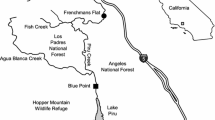Abstract
Standing crop, population size, and species diversity of the macrobenthic organisms in an estuarine channel were studied before and after dredging. A new suction-corer which sampled an area 0.1 m2 to a depth of 30 cm was used in order to insure the inclusion of large, deep-dwelling animals. Eleven months after dredging, biomass and number of species and specimens had not recovered to pre-dredging levels. Colonization began with relatively large, swiftly moving forms such as the errant polychaete Nereis succinea and the crab Neopanope texana sayi. Stations in silt and mud regions recovered more slowly than those in sandier sediments. Most of the dominant and subdominant species had not recovered 11 months after dredging, and the previously abundant polychaetes Notomastus latericeus and Clymenella torquata had virtually disappeared. Only relatively uncommon lamellibranchs such as Tellina agilis, Lyonsia hyalina and Mulinia lateralis increased after dredging. Distribution of sediment types changed as the result of modified tidal velocities in the channel. Mud and silt were removed by the dredge, exposing the sand underneath, and sandy stations became muddier as the result of lowered current velocities. Marked changes in species composition reflected this change in sediment character. Eleven months after dredging no evidence of succession was found, but colonization had begun. Values of all three parameters studied were reduced to small fractions of pre-dredging levels, although species diversity in sandy sediments exceeded pre-dredging levels.
Similar content being viewed by others
Literature Cited
Biggs, R.B.: Environmental effects of overboard spoil disposal. J. sanit. Engng Div. Am. Soc. civ. Engrs 94 (SA3) 5979, 477–478 (1968)
Cassin, J.M.: A study of the phytoplankton cycle in Goose Creek, New York, 1966–1967, Ph. D. Dissertation, Fordham University, New York 1968
Dexter, R.W.: The marine communities of a tidal inlet at Cape Ann, Massachusetts. Ecol. Monogr. 17, 261–294 (1947)
Fazio, F.R.: The effects of dredging on the nutrient cycle in Goose Creek, New York, 1967–1968, Ph. D. Dissertation, Fordham University, New York 1969
Hair, M.E.: A study of the nutrient cycles in Goose Creek, New York, 1966–1967, Ph. D. Dissertation, Fordham University, New York 1968
Harrison, W., M.P. Lynch and A.G. Altschaeffl: Sediments of lower Chesapeake Bay, with emphasis on mass properties. J. sedim. Petrol. 34, 727–766 (1964)
Holme, N.A.: The biomass of the bottom fauna in the English Channel off Plymouth. J. mar. biol. Ass. U.K. 32, 1–49 (1953)
— and A.D. McIntyre (Eds.): Methods for the study of marine benthos, 334 pp. I.B.P. Handbook No. 16, Oxford: Blackwell Scientific Publications (International Biological Programme) 1971
Hjulstrom, F.: Transportation of detritus by moving water. In: Recent marine sediments, pp 5–31. Ed. by P. Trask. New York: Dover Publishers 1955
Kaplan, E., J.R. Welker and M.G. Kraus: A shallow-water system for sampling macrobenthic infauna. Limnol. Oceanogr. 19, 346–350 (1974a)
——: Some effects of dredging on populations of macrobenthic organisms. Fish. Bull. U.S. 72, 445–480 (1974b)
McNulty, J.K., R.C. Work and H.B. Moore: Some relationships between the infauna of the level bottom and the sediment in south Florida. Bull. mar. Sci. Gulf Caribb. 12, 322–332 (1962)
Murawski, W.S.: A study of submerged dredge holes in New Jersey estuaries with respect to their fitness as finfish habitat. Misc. Rep. Fish. Lab. New Jers. 2-M, 1–32 (1969)
Newcombe, C.L.: Certain environmental factors of a sand beach in the St. Andrews region, New Brunswick, with a preliminary designation of the intertidal communities. J. Ecol. 23, 334–335 (1935)
Nuzzi, R.: A study of the bacterial cycle in Goose Creek, New York, 1966–1968, Ph. D. Dissertation, Fordham University, New York 1969
O'Connor, J.S.: The benthic macrofauna of Moriches Bay, New York, Biol. Bull. mar. biol. Lab., Woods Hole 142, 84–102 (1972)
Pfitzenmeyer, H.T.: Benthos. In: Gross physical and biological effects of overboard spoil disposal in upper Chesapeake Bay. Spec. Rep. Univ. Maryl. nat. Resour. Inst. 3, 26–38 (1970)
Reish, D.J.: A discussion of the importance of the screen size in washing quantitative marine bottom samples. Ecology 40, 307–309 (1959)
—: A study of succession in recently constructed marine harbors in southern California. Proc. natn. Conf. cstl shallow Wat. Res. (Baltimore) 1, 570–573 (1962)
—: Further studies on the benthic fauna in a recently constructed boat harbor in southern California. Bull. Sth. Calif. Acad. Sci. 62, 23–32 (1963)
Rhoads, D.C. and D.K. Young: The influence of deposit feeding organisms on sediment stability and community trophic structure. J. mar. Res. 28, 150–178 (1970)
Sanders, H.L.: Oceanography of Long Island Sound, 1952–1954. X. Biology of marine bottom communities. Bull. Bingham oceanogr. Coll. 15, 346–414 (1956)
—: Benthic studies in Buzzards Bay. I. Animalsediment relationships. Limnol. Oceanogr. 3, 245–258 (1958)
Slotta, L.S., C.K. Sollit, D.A. Bella, D.R. Hancock, J.E. McCauley and R. Parr: Effects of hopper dredging and channel spoiling in Coos Bay, Oregon. Interdisciplinary Studies, School of Engineering, School of Oceanography, Oregon State University (1973). (Internal publication)
Stickney, A.P. and L.D. Stringer: A study of the invertebrate bottom fauna of Greenwich Bay, Rhode Island. Ecology 36, 111–122 (1957)
Stone, R.B.: A quantitative study of benthic fauna in lower Chesapeake Bay with emphasis on sediment relations, M.S. Thesis, College of William and Mary, Williamsburg, Virginia 1964
Taylor, J.L. and C.H. Saloman: Some effects of hydraulic dredging and coastal development in Boca Ciega Bay, Florida. Fishery Bull. Fish Wildl. Serv. U.S. 67, 213–241 (1968)
Author information
Authors and Affiliations
Additional information
Communicated by O. Kinne, Hamburg
Portions of this investigation were supported by a grant from Suffolk County, New York, USA.
Rights and permissions
About this article
Cite this article
Kaplan, E.H., Welker, J.R., Kraus, M.G. et al. Some factors affecting the colonization of a dredged channel. Mar. Biol. 32, 193–204 (1975). https://doi.org/10.1007/BF00388512
Accepted:
Issue Date:
DOI: https://doi.org/10.1007/BF00388512




